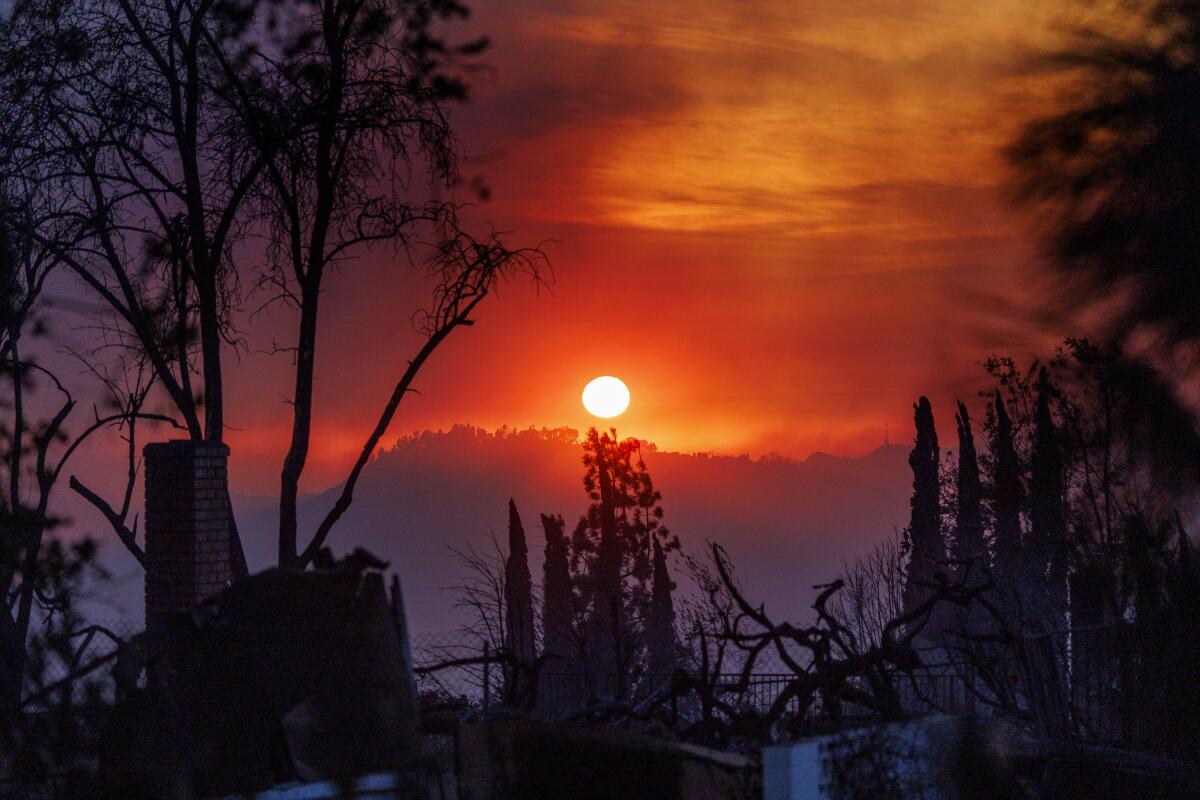Opinion: Where does resilience come from?

- Share via
As I write this, I am watching the smoke billow up from Altadena, a mile away. Three friends have already told me they lost their homes. I am trying to find my neighbor to deal with a damaged tree in her yard about to fall on my house, but she isn’t here.
We are almost certainly experiencing the costliest wildfires in the history of Southern California. We have lost much and will be working to recover for a long time to come. Knowing that in the face of climate change, the title of “costliest fire ever” will probably not last for very long, we must increase our resilience for this new reality.
Resilience is the ability to bounce back from a disaster. Research into how recovery happens has shown that the most important factor in a resilient community is the level of what social scientists call “social capital,” the value derived from positive connections between people. The rest of us call this “relationships.” How connected are you to others in your business community? Or your kids’ schools or your faith community? How strong are your family connections? These bonds create community and are the reason and the way we work to rebuild.
A request from the fire department was misconstrued online, illustrating the untapped resource of civic-minded neighbors eager to pitch in.
But right now, before we can think about recovery, we are all coping with fear and grief. Our first response to fear is to find ways to avoid the risk. Do I evacuate? Do I try to stay and protect my home? If I have lost my home, where do I go? I’m not in the evacuation zone but how do I protect my family from the bad air? But with fear can come a feeling of powerlessness, especially if we are grieving. When we feel powerless, we don’t act, and the inability to act increases fear and we may spiral toward depression.
Our social bonds do more than just motivate and sustain us in the long process of recovery. They give us purpose during this difficult time of response. We are wired to avoid risk, but we are more willing to face risk when we are helping others. We stop focusing on our fear or loss and take pride in helping the community.
You can do this now. It could be as simple as texting a friend to let them know you are thinking about them. Offer a place to stay. Volunteer at the evacuation centers. Help at the animal shelters. Make a donation to a food bank or another social service group. Helping others will make the experience manageable.
Coverage of the fires ravaging Altadena, Malibu, Pacific Palisades and Pasadena, including stories about the devastation, issues firefighters faced and the weather.
As natural disasters get worse and more common, we will need resilience more than ever. First, we need to acknowledge that the “unthinkable” must be thought about. Climate-driven extreme events — wind, rain storms and drought — are all becoming more common. Our ecosystems evolved for a different climate from what they are currently experiencing, and wildfire is how those ecosystems adapt.
Second, in the face of this increased frequency of disasters, society’s mechanisms for managing and mitigating risk will need to change. For instance, the most common mechanism is insurance — we pay someone to take on some of the risk for us. But as the risk increases, that approach can quickly become unsustainable. We will need to find alternatives, such as the implementation of a comprehensive national hazards insurance program, the way the California Earthquake Authority has managed California’s earthquake insurance issue.
When it comes to the fires, there’s a lot to talk about. But can we do so as grown-ups, without using an epic disaster as a political piñata?
Major disasters like this week’s fires disrupt so much that they can be an opportunity to rebuild into something better, and we must make sure that our responses strengthen the community. Successful recovery after the last decade of California wildfires was fostered by the early formation of community collaboratives, which bring together organizations such as local chambers of commerce, churches and neighborhood associations. For example, the North Valley Community Foundation, in Chico, distributed philanthropic relief funding after the Camp, North Complex and Dixie fires through collaboratives, so the community organizations agreed on solutions and weren’t competing with each other for the aid.
Resilience and building our social capital start with a conversation. Talk to your neighbor, connect with someone new whom you see at your children’s school, your place of worship or a nearby restaurant or coffee shop.
For many in Southern California, these 2025 fires won’t be why they need to be resilient. But we will have other extreme weather events to contend with, and at some point, we will have an earthquake that will affect all of us. Those who are connected to each other will recover faster and have a reason to thrive again.
Lucy Jones is the founder of the Dr. Lucy Jones Center for Science and Society and the author of “The Big Ones: How Natural Disasters Have Shaped Us (and What We Can Do About Them).”
More to Read
A cure for the common opinion
Get thought-provoking perspectives with our weekly newsletter.
You may occasionally receive promotional content from the Los Angeles Times.













